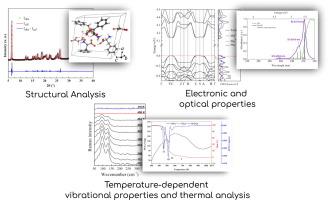l -苯丙氨酸丙二酸盐晶体的结构、光电和振动特性:实验和理论方法
IF 4.6
2区 化学
Q1 SPECTROSCOPY
Spectrochimica Acta Part A: Molecular and Biomolecular Spectroscopy
Pub Date : 2025-09-12
DOI:10.1016/j.saa.2025.126937
引用次数: 0
摘要
对l -苯丙氨酸l -苯丙氨酸丙酸盐晶体(LPPMA)进行了实验和计算相结合的研究,探讨了其结构、电子、振动和热性能。x射线衍射分析证实LPPMA在单斜P2₁空间群中结晶,两性离子和阳离子苯丙氨酸分子与丙二酸阴离子形成氢键层并正交疏水堆叠。分子和固态(周期)DFT计算也进行了。LDA-D带结构显示出4.14 eV的准简并基电子隙,最高已占和最低未占晶体轨道(HOCO和LUCO)分别位于Phe和Phe+单元上。利用HSE06进行的互补混合功能计算产生了5.48 eV的带隙增加,提供了更准确的上限估计,与材料的绝缘特性一致。TD-DFT/B3LYP分子计算预测了5.69 eV的强垂直激发,与5.99 eV的最强紫外-可见吸收带接近。温度相关的拉曼光谱(298-468 K)显示出振动模式的红移和逐渐的强度损失,最终在468 K以上出现不可逆的光谱抑制。DFPT模拟支持振动赋值,并阐明了热应力下超分子相互作用在稳定晶体结构中的作用。热重和热分析确定了一个五步热降解过程,与NH₃、CO₂和CH₂片段的顺序释放有关。本文章由计算机程序翻译,如有差异,请以英文原文为准。

Unraveling the structural, optoelectronic and vibrational properties of L-phenylalanine L-phenylalaninium malonate crystal: An experimental and theoretical approach
A combined experimental and computational investigation was conducted on the crystal L-phenylalanine L-phenylalaninium malonate (LPPMA) to explore its structural, electronic, vibrational, and thermal properties. X-ray diffraction analysis confirmed that LPPMA crystallizes in the monoclinic P2₁ space group, with zwitterionic and cationic phenylalanine molecules and malonate anions forming hydrogen-bonded layers and orthogonal hydrophobic stacking. Molecular and solid-state (periodic) DFT calculations were also performed. The LDA-D band structure revealed a quasi-degenerate fundamental electronic gap of 4.14 eV, with the highest occupied and lowest unoccupied crystal orbitals (HOCO and LUCO) localized on Phe and Phe+ units, respectively. Complementary hybrid functional calculations using HSE06 yielded an increased band gap of 5.48 eV, providing a more accurate upper-bound estimate in agreement with the material's insulating character. TD-DFT/B3LYP molecular calculations predicted a strong vertical excitation at 5.69 eV, in close agreement with the most intense experimental UV–vis absorption band at 5.99 eV. Temperature-dependent Raman spectroscopy (298–468 K) demonstrated redshifts and progressive intensity loss of vibrational modes, culminating in irreversible spectral suppression above 468 K. DFPT simulations supported vibrational assignments and elucidated the role of supramolecular interactions in stabilizing the crystal structure under thermal stress. Thermogravimetric and thermal analyses identified a five-step thermal degradation process, associated with the sequential release of NH₃, CO₂, and CH₂ fragments.
求助全文
通过发布文献求助,成功后即可免费获取论文全文。
去求助
来源期刊
CiteScore
8.40
自引率
11.40%
发文量
1364
审稿时长
40 days
期刊介绍:
Spectrochimica Acta, Part A: Molecular and Biomolecular Spectroscopy (SAA) is an interdisciplinary journal which spans from basic to applied aspects of optical spectroscopy in chemistry, medicine, biology, and materials science.
The journal publishes original scientific papers that feature high-quality spectroscopic data and analysis. From the broad range of optical spectroscopies, the emphasis is on electronic, vibrational or rotational spectra of molecules, rather than on spectroscopy based on magnetic moments.
Criteria for publication in SAA are novelty, uniqueness, and outstanding quality. Routine applications of spectroscopic techniques and computational methods are not appropriate.
Topics of particular interest of Spectrochimica Acta Part A include, but are not limited to:
Spectroscopy and dynamics of bioanalytical, biomedical, environmental, and atmospheric sciences,
Novel experimental techniques or instrumentation for molecular spectroscopy,
Novel theoretical and computational methods,
Novel applications in photochemistry and photobiology,
Novel interpretational approaches as well as advances in data analysis based on electronic or vibrational spectroscopy.

 求助内容:
求助内容: 应助结果提醒方式:
应助结果提醒方式:


